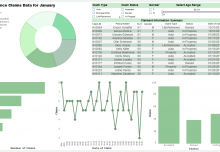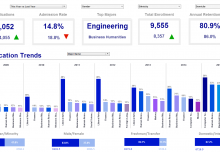A question that has recently come up is which direction InetSoft is going with regards to using Flash or HTML5 for the client-side functions of its BI solution. HTML5 certainly presents opportunities, but there are several reasons why not to completely switch over to HTML5 and abandon Flash.
First of all, there seems to be some sort of misconception that Flash and HTML5 cannot coexist. This is not true. As you will see, there are pros and cons to each technology, and they each have their place on the Web. Thematically, at least, HTML5 and Flash are almost identical.
Penetration
Flash has been around for 12 years and has an absolutely mammoth head start over HTML5, which has only been recommended for use since December 2012. For developers, the Flash IDE has a huge user base and community, while HTML5 does not yet have an “industry standard.”
For users, about 99% of desktop Web browsers support Flash, as well as:
- 85% of the most visited Websites
- 75% of all video content
- 98% of enterprises
Flash’s main shortcoming, however, is that browsers cannot natively read it; they require a separate plug-in to be installed. Fortunately, these same browsers support this add-on.
HTML5 is an independent technology and readable without the need for a plug-in. But, being a technology very much in its infancy, not all browsers are coded to support it.
According to a study conducted by Waste-Creative, HTML5 is fully supported by 82% of desktop browsers, but completely unsupported by all versions of Internet Explorer 8 and below, with IE9 and IE10 offering only limited support.
The area where HTML5 excels is mobile: 97% of mobile browsers support HTML5; devices running iOS or Android v4.1 or above do not support Flash. On Android, this is the minority of devices, with millions of users still using Android v4.0 or below. In the case that you are a user without access to Flash, we ensure that dashboards are rendered using HTML5 instead.
However, mobile developers are opting for native apps because of the significant advantages they have over HTML5. Mark Zuckerberg, founder of Facebook, said that he regretted developing with HTML5.
Development
Due to Flash’s high penetration, developers are more familiar with the platform. Even amateurs can present items that look as though they were developed by professionals. HTML5, on the other hand, is limited by its relative newness; advanced functionality takes more time and more specialized developers. Even the most capably developed HTML5 site will lack some functionality that an experienced Flash developer can offer.
One of the trickiest parts of developing an HTML5 Website is that, even though almost all major browsers can read the language, they interpret it differently. Web browsers render HTML5 in their own way, so it may be necessary to code multiple versions of pages for full, working browser neutrality. Flash has much better cross-browser compatibility.
Performance
In 2012, Flash performed twice as fast as HTML5 on most applications. As of 2012, HTML5 has gained some ground, but it’s still not as good as Flash in all areas. Before the code even executes, you have to consider the load time. HTML5 is much heavier than Flash, because it uses HTML and JavaScript instead of pre-compiled code. As such, it is impaired by significantly longer load times.
Security
In this category, Flash is the clear winner. Flash is expensive to develop for, requiring a licensed product from Adobe, but digital rights management (DRM) makes it very difficult to steal content. HTML5 is free and open to developers, which is great, but content can be ripped through the simple “right-click, save as…” function that everyone is familiar with. In order to combat this, special servers are necessary to manage HTML5’s DRM.
Conclusion
Flash and HTML5 each have their quirks. For InetSoft, right now the pros of Flash outweigh the cons when compared to HTML5. We prefer the speed and compatibility we can deliver with Flash, but support both languages to accommodate user preference.
As mentioned before, both technologies have their place. Flash offers advanced functionality that is continuing to grow at a rapid rate. HTML5 is currently playing catchup with decent functionality for all ecosystems
HTML5 might be the tech of the future, but it’s not quite there yet.



